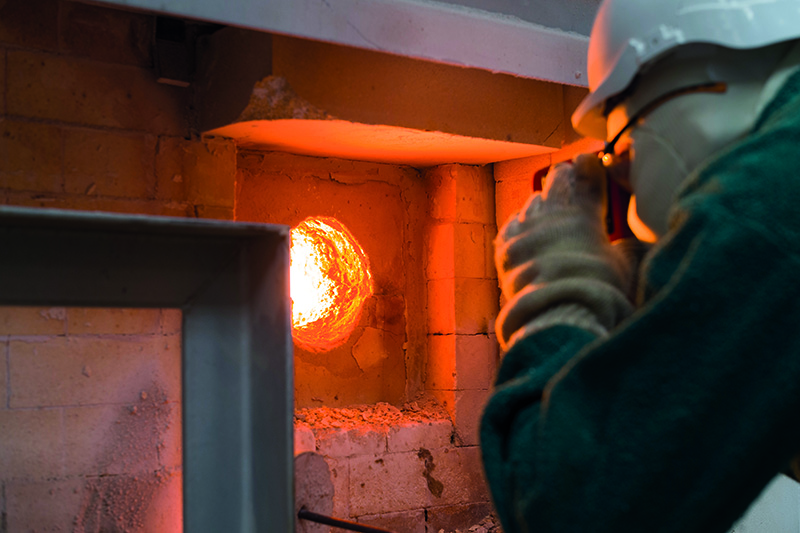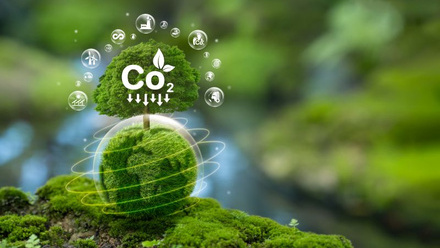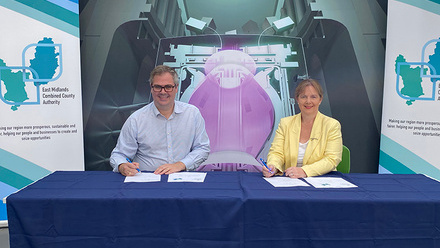Flat glass production achieved using 30% hydrogen
Saint-Gobain is reported to be the first manufacturer in the world to carry out a production test of flat glass using more than 30% hydrogen during trials at its Herzogenrath site in Germany.

Saint-Gobain glass production
© ChristelSasso_CAPA PICTURES
Saint-Gobain claims to have proven the technical feasibility of manufacturing flat glass with a significant proportion of hydrogen. This will complement its other decarbonised energy sources and will reduce the site’s direct CO₂ emissions (Scope 1) by up to 70%. This was made possible by an R&D programme launched in 2022, drawing on the Group’s experience in combustion, glass quality, ceramic refractories materials and industrial furnace design.
A spokesperson for Saint-Gobain, says, 'Some competitors have already mentioned trials with hydrogen on their floats, but none have used as much as 30%...Of course, some parameters needed adaptation, but nothing changed at a process scale.
'The aim of this trial at our flat glass manufacturing facility in Herzogenrath was to see how production parameters must evolve, and then be able to replicate the learnings on many plants once low-carbon hydrogen is available in sufficient quantities.'
However, they could not yet reveal what these parameters are, or the learnings made, as the spokesperson says, 'We are still in this R&D phase'.
Glass production at Saint-Gobain involves a batch of glass being made of ingredients silica, soda ash, lime, dolomite, recycled glass (cullet) and additives that are adjusted according to desired colour and properties.
Raw materials are melted in a furnace at more than 1,500°C. The thermal energy of the flames is recovered in the regenerators, while that of the fumes can be used to produce electricity or to heat the industrial site. Forming molten glass is then poured onto a bath of liquid tin.
Gear wheels stretch or push the glass to obtain the required thickness (2-19mm) and width (3-5m).
The glass passes through a cooling tunnel over 100m long, to drop from 600°C to room temperature while controlling the product’s thermal and mechanical stresses.
Regular checks are made and samples taken to verify the quality of the glass, which is automatically cut into sheets of 1-20m². The glass sheets are then stored in the warehouse.
According to Saint-Gobain, 'Using one tonne of cullet in the manufacturing of flat glass saves 300kg of CO₂. Saint-Gobain uses more than 30% of cullet in its production, with an objective of 40% in 2030.'
The hydrogen programme forms part of a roadmap towards carbon neutrality in 2050. It was carried out in collaboration with the independent German laboratory Gas and Heat Institute Essen e.V. and financially supported by the Land of North Rhine-Westphalia to the amount of €3.64mln.
These industrial tests at Herzogenrath have been preceded on a laboratory scale by trials carried out in two research centres in France – Saint-Gobain Research Paris in Aubervilliers and Saint-Gobain Research Provence in Cavaillon.
Analysis of the data from these tests will make it possible to deploy hydrogen in the Group’s floats in the decades to come.
The firm says it complements R&D initiatives on the electrification of glass melting and the world’s first zero-carbon production of flat glass at Aniche, France, in May 2022, thanks to 100% cullet and 100% decarbonised biogas energy.







